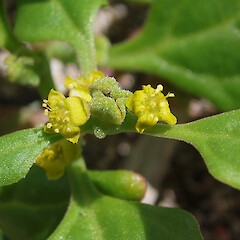Tetragonia tetragonoides
Common name
kōkihi, New Zealand spinach, tutae-ikamoana
Synonyms
Demidovia tetragonoides Pall., Tetragonia cornuta Gaertn., Tetragonia expansa Murray nom. illegit., Tetragonia halimifolia G.Forst., Tetragonia inermis F.Muell.
Family
Aizoaceae
Flora category
Vascular – Native
Endemic taxon
No
Endemic genus
No
Endemic family
No
Structural class
Lianes & Related Trailing Plants - Dicotyledons
Chromosome number
2n = 96
Current conservation status
The conservation status of all known New Zealand vascular plant taxa at the rank of species and below were reassessed in 2017 using the New Zealand Threat Classification System (NZTCS) – more information about this can be found on the NZTCS website. This report includes a statistical summary and brief notes on changes since 2012 and replaces all previous NZTCS lists for vascular plants.
Please note, threat classifications are often suggested by authors when publications fall between NZTCS assessment periods – an interim threat classification status has not been assessed by the NZTCS panel.
- Conservation status of New Zealand indigenous vascular plants, 2017 . 2018. Peter J. de Lange, Jeremy R. Rolfe, John W. Barkla, Shannel P. Courtney, Paul D. Champion, Leon R. Perrie, Sarah M. Beadel, Kerry A. Ford, Ilse Breitwieser, Ines Schönberger, Rowan Hindmarsh-Walls, Peter B. Heenan and Kate Ladley. Department of Conservation. Source: NZTCS and licensed by DOC for reuse under the Creative Commons Attribution 4.0 International licence.
2017 | At Risk – Naturally Uncommon | Qualifiers: EF, RR, SO, Sp
Previous conservation statuses
2012 | At Risk – Naturally Uncommon | Qualifiers: EF, SO, Sp
2009 | At Risk – Naturally Uncommon | Qualifiers: EF, SO
2004 | Sparse
Distribution
Indigenous. Kermadec, Three Kings, North, South, Stewart and Chatham Islands. Also present in Australia, the western Pacific, Malesia, Japan and southern South America.
Habitat
A species of the coastal strand zone often growing along beaches amongst driftwood, and sea weed but also in sand dunes, on boulder and cobble beaches, on cliff faces and rock ledges and in some areas such as the Kermadec Islands an conspicuous and important associated of the vegetationof many of the outer islands in the archipelago. Partly because it has been cultivated as a vegetable this species often appears in landfills or as a casual weed of urban areas. Indeed some wild occurrences near urban coastal settlements may stem from discarded plants or seed in garden waste.
Detailed description
Widely trailing perennial herb forming dense patches, circular mats, or rarely mounds of interlacing branches up to 1 m thick. Branches up to 1 m long, bright to dark green or yellow green, subterete, numerous, woody near base, decumbent, trailing not or only rarely rooting at nodes. Petioles firmly fleshy up to 20 mm long. Leaves 15-80 x 10-60 mm, dark green to yellow green, darker above and paler beneath, ovate-rhomboid, rhomboid to triangular, obtuse to subacute, entire or rarely slightly sinuate or shallowly lobed, both surfaces very densely though finely papillose. Flowers solitary or paired, mostly perfect sometimes unisexual, subsessile, 7-8 mm diameter, perianth dark yellow to pale yellow (rarely yellow-green). Calyx-tube broadly turbinate, lobes broad-triangular, obtuse. Stamens variable but between 10-20. Ovary 3-8-celled, styles 3-8. Fruit 8-10(15) mm long, subturbinate, angled, woody horns 2-4 apical, sharp to blunted-ended, seeds 4-10.
Similar taxa
Tetragonia trigyna is similar but has reddish stems, more usually broadly ovate or deltoid leaves, distinctly pedicellate flowers and globose rather than turbinate, succulent rather than woody, red fruits lacking horns.
Flowering
October-February
Flower colours
Green, Yellow
Fruiting
November - March
Propagation technique
Easily grown from seed and once established self-sows freely. A moderately popular vegetable whose seed is sold as New Zealand Spinach. Frost tender but once established usually resprouts from the base when warmer weather returns.
Threats
It is threatened by disturbance of coastal sands and stony beaches.
Etymology
tetragonia: Four-angled
Where To Buy
Seed and plants often sold by main stream garden centres, often in the herb section or as a New Zealand vegetable.
Attribution
Fact Sheet prepared for NZPCN by P.J. de Lange 1 February 2008. Description based on Allan (1961)
References and further reading
Allan, H.H. 1961: Flora of New Zealand. Vol. I. Wellington, Government Printer.
Wilcox, M.D. New Zealand spinach in Mangere. Auckland Botanical Society Journal, 56: 82
NZPCN Fact Sheet citation
Please cite as: de Lange, P.J. (Year at time of access): Tetragonia tetragonoides Fact Sheet (content continuously updated). New Zealand Plant Conservation Network. https://www.nzpcn.org.nz/flora/species/tetragonia-tetragonoides/ (Date website was queried)



















